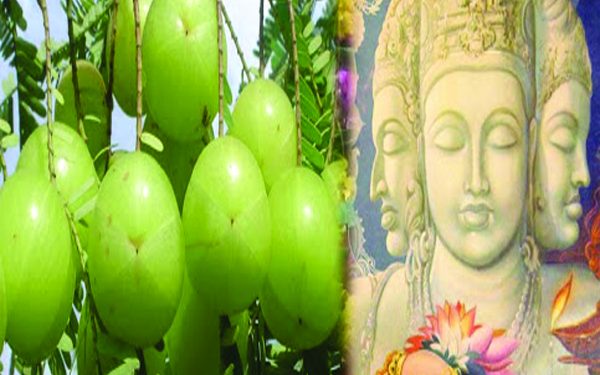Bhubaneswar: Keeping in mind the COVID-19 pandemic in Odisha, the Puri district administration announced the imposition of Section 144 around the Sakhigopal Temple’s premises on the occasion of ‘Anla Nabami’, or ‘Radha Pada Darshan’.
Amid such gloomy scenes, Anla Nabami, a major Hindu festival of Odisha, beginning Monday has apparently seen muted celebrations.
Many Hindu festivals have been prescribed to keep the observers far from diseases. ‘Anla Nabami’ is one of them. Since it is observed on the ninth day in the month of Kartika, it is called ‘Anla Nabami’.
According to experts, Anla (Amla), the Indian gooseberry, is high in medicinal value. Perhaps that is the reason the ancient Hindu concept makers dedicated a day in a year to worship the Anla tree so that people come to know about the many benefits of the fruit.
Anla Nabami is mostly observed in Odisha.
As per legend, once a Chandala went hunting in the forest. While he hunted for birds and deer, he felt hungry. Seeing an Amla tree, he climbed it and ate the sweet fruits. Unfortunately, as he began to climb down, he fell and died. When Yam raj’s attendants came to take away his soul, they could not do so. This baffled Yam raj to a great extent and he sought the help of the sages. They enlightened him by saying that they couldn’t approach the Chandala’s body as he had consumed amla just before he died.
The festival is also called ‘Akshaya Navami’ and is observed on ‘Shukla Navami’ day in the Kartik month. In West Bengal, this day is also known as ‘Jagaddhatri puja’. According to Padma Purana, Amla has much religious significance attached to it as it is a fruit known to be very dear to Lord Vishnu.
According to Dr. Surendra Kumar Sahoo, medicinal uses of Amla or Amalaki have been a part of Ayurvedic medicine for more than thousand years. Both dried and fresh Indian gooseberry has great health benefits. One of which is that it acts like a coolant if taken after meals.

It is an excellent source of vitamin C. It is also helpful to fight with the COVID-19 disease as i tcontains vitamin-c. Amla juice is the best tonic to make you look and feel young. It is the integral component of Triphala, an ayurvedic formulation, which is used to cure many diseases. Amla balances the three ‘doshas’ – ‘vata’, ‘pitta’ and ‘kapha’.
It prevents cancer due to the presence of some important polyphones. The gooseberry tree is a medicinal plant with tremendous uses and benefits. Hence to preserve this precious species may be the tradition of worshipping gooseberry tree has taken root.
Dillip Kumar Mishra a priest says, Anla Nabami is basically observed by women. After a sacred bath early in the morning and then wearing new or fresh clothes, devotees assembled near a gooseberry tree. In the absence of an amla tree, a branch of the tree earthed on the ground or in a vase, can also be worshipped. People worship the gooseberry tree facing east. First a lamp is lit with a prayer to keep burning till the end of the worship. That is called ‘akhanda’. Then devotees pour water and milk on the tree. After that, they apply roli, the Indian red sacred powder, on the tree. They also offer a sari and blouse piece. The next step is to show ‘dhup’. And then Moli, the sacred red thread, is tied by all women on the tree, who move seven times circling the tree. It is followed by a ‘katha’ either read by a woman or a Brahmin priest, to be listened by all the devotees. The final step is ‘arati’ and then women put sindoor or roli to each other’s forehead to have fun in an auspicious way. Women should include gooseberry or aanvla in their food on the day of Aanvla Navami.
Consuming amla on a daily basis ensures a long healthy life. Amla is the greatest boon to humanity and one of the effective traditional herbal medicines, which had been used to treat and manage diseases since ancient times. The Indian gooseberry is the reservoir of minerals, vitamins and other bio-chemical substances. To some extent, it is bitter in taste but the ayurvedic marvel can be used in many forms such as eaten raw, or as juice, chutney, pickle, murabba, and also used with other recipes. Amla is good to prevent hair loss and plays a vital role in the overall health of hair. Drinking of amla juice is good to prevent hair fall and dandruff and split ends because of abundance of protein. The mix of juices of amla and lemon when applied on the scalp and left it for 20 minutes followed by washing helps to strengthen the hair follicles and hair shaft. It also enhances hair loss, colour and pigmentation. Regular intake of amla juice makes your hair darker and thicker and also prevents graying. Applying the amla paste helps make your hair grow dark and lustrous. Amla prevents baldness due to the presence of carotene and iron. Amla ensures proper absorption of calcium that is directly or indirectly beneficial for lustrous hair including bones, teeth and nails.
PNN






































